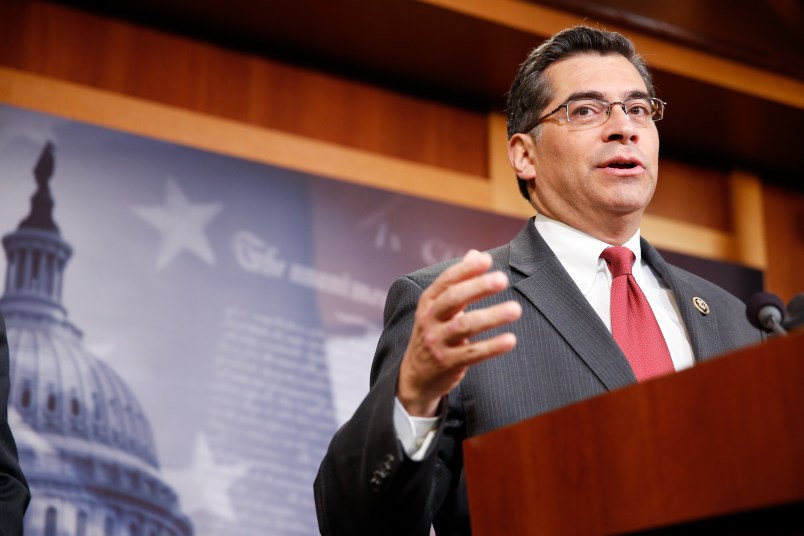On the first day of the 114th Congress, Republicans moved to block the routine transfer of tax revenues between Social Security’s disability and retirement funds. The move was seen as a way to leverage deep, substantive changes to the Social Security program that Republicans have sought for years. But what if no routine transfer was required in the first place?
Democrats on the Ways and Means subcommittee on Social Security are considering introducing legislation that would combine the Social Security Disability Insurance Fund with the Old-Age Survivors Insurance (OASI) Fund —commonly referred to as the retirement fund, TPM has learned.
The so-called “reallocation” between the two funds — which has occurred periodically for decades on a mostly bipartisan basis — would no longer be required. Such a move would take Congress out of the mix and allow the funds to be managed as one.
A bill combining the two funds would be a direct counterpunch to Republicans’ move to block transferring funds between the two programs.
The legislation is likely to come from the House Ways and Means subcommittee on Social Security where Rep. Xavier Becerra (D-CA) is the ranking member and Rep. Sam Johnson (R-TX) is the chairman. Becerra’s office declined to comment on the issue or whether he is preparing to introduce such a bill.
There are pros and cons to combining the two funds. For one, having one fund would mean there wouldn’t need to be revenue transfers.
“Now having one big pot of money and one trust fund and not having to worry what to do if one of the trust funds is running low on money, that might be a good idea,” Tom Hungerford, a senior economist at the liberal Economic Policy Institute told TPM.
Another incentive is that the public already considers Social Security one program with one fund and one insolvency deadline. The insolvency dates for the funds, George Mason University Mercatus Center senior research fellow Jason Fichtner said, is usually reported as “one number for both programs.” Right now that date is 2033 for the entire Social Security program. The disability fund is projected to start running out of money in late 2016, and 2034 for the retirement fund. Combining the funds would make that one solvency number more accurate.
“2034 is for retirement, 2016 is for disability, but way too often the public just hears one number and so for many they don’t actually understand that they’re two separate programs, they just think it’s one program,” said Fichtner, a top official at the Social Security Administration under President George W. Bush.
Experts cited another incentive, too: getting rid of the stigma that the disability program is being hijacked by moochers.
“The perception is that it’s full of fraud, waste, and abuse,” Fichtner said of the disability insurance program. “For example, Puerto Rico, which recently had issues of fraud and which many people got disability insurance because they spoke Spanish and Spanish was considered a disability under the vocational grid. But of course, they’re in Puerto Rico where speaking Spanish would not be a debilitating injury.”
Fichtner also pointed to New York where 106 firefighters and police officers were charged in a massive fraud scheme involving the Social Security disability insurance program. Combining the funds, the argument goes, would get rid of some of the stigma about the disability program.
“So I think from a Democrat’s standpoint they are seeing the landscape changing against them because the public perception is that D.I. program is full of fraud, waste, and abuse,” Fichtner said.
The flipside is that keeping the funds separate highlights when one fund has a problem.
“There is a benefit for having the trust funds separate,” Fichtner said. “For example, if they weren’t separate now, you and I might not be talking because the disability program’s problems would be masked into the larger combined trust fund’s and the problem would be looked off until 2033. So a benefit of keeping it separate is that you and I have separate discussions about the different programs and the problems facing those two programs.”
Last week George Mason University Mercatus Center senior research fellow Charles Blahous published a piece at The Manhattan Institute’s economics21.org analyzing the idea of combining the two funds. He argued that merging the two funds would effectively encourage fiscal irresponsibility.
“Merging the OASI and DI trust funds would implicitly require only that Social Security as a whole be self-financing, abandoning the requirement that each of its components be sustainable on its own,” Blahous wrote. “Once the principle of self-financing is abandoned for individual components of Social Security it becomes less clear where the line of fiscal responsibility will remain drawn.”
Either way, legislation combining the two funds is unlikely to advance far in the Republican-controlled House of Representatives. Democrats, however, have been eager to discuss moves to sustain or expand Social Security lately while Republicans, including 2016 presidential contenders, have recently been calling for cuts. The incentive for Democrats is to highlight what they say are Republican moves to manufacture a Social Security crisis to leverage radical changes to the 70-year-old program.
TPM reached out to the office Sen. Sherrod Brown (D-OH), one of the most outspoken proponents of Social Security. Brown’s office signaled that the senator would likely support combining the funds.
“Because of reallocation, they essentially function as a single fund. So in theory, yes, he supports this,” Brown spokeswoman Meghan Dubyak told TPM.










Just another pointless workaround of the Republican inability/unwillingness to govern competently.
“He argued that merging the two funds would effectively encourage fiscal irresponsibility.”
Much like the merger of a couple of large banks.
In other words, “Combining the two funds in law, the way they’re effectively combined in practice, would make it harder for us to chip away at each program individually. That in turn would delay the day when we can kill Social Security entirely.”
I say, keep the funds separate.
I worked my way up from Mail Clerk to Claims Representative over 8 years with Social Security so I know the local level from top to bottom.
They call it something else now, but basically a claims rep takes applications, requests proofs, evaluates the application and the proofs, and then either approves the application or denies it. The case goes from district to region and beyond, but for a full level claims rep, only a small percentage of their cases are reviewed.
That is an awful lot of power to put into the hands of hundreds of mid-grade federal employees. (The pay grade runs from GS-7, GS-9, then GS-11, or did back then.) Also, they have some very difficult working conditions. They are always understaffed and overworked.
To receive regular social security is rather simple and straight forward. With public records so readily available, there are few gray areas.
Disability is a far more complicated issue. In one small office it became apparent to me that there was disparity in administering this program. One rep had a much higher denial rate than others. He seemed to think that everyone was freeloading. However, he was able to justify every claim he denied
A disability claim requires a lot of input of observations and conclusions from the interviewer (claims rep). These narratives leave a lot of room for manipulation. When I became a claims rep I soon realized that my observation skills and descriptive skills could make the difference of whether I could justify approving or denying an application. Also, I could decide what proofs to collect, and I also got to evaluate those proofs. All of this after a 6-week intensive course of study.
No, there’s too much room for error in disability… Let it stand on it’s own so that it can have the scrutiny it needs.
There is so much the Democrats could do if they would get off their collective asses and remember that their job is to serve the citizens of this country rather than those who are filling their collective pockets with profits.
I am so disillusioned and disappointed in the entire Democratic Party they dither and dance around the issues and cower in the corners of their offices while the craven and crazy take over the country.
They have become deaf mutes.